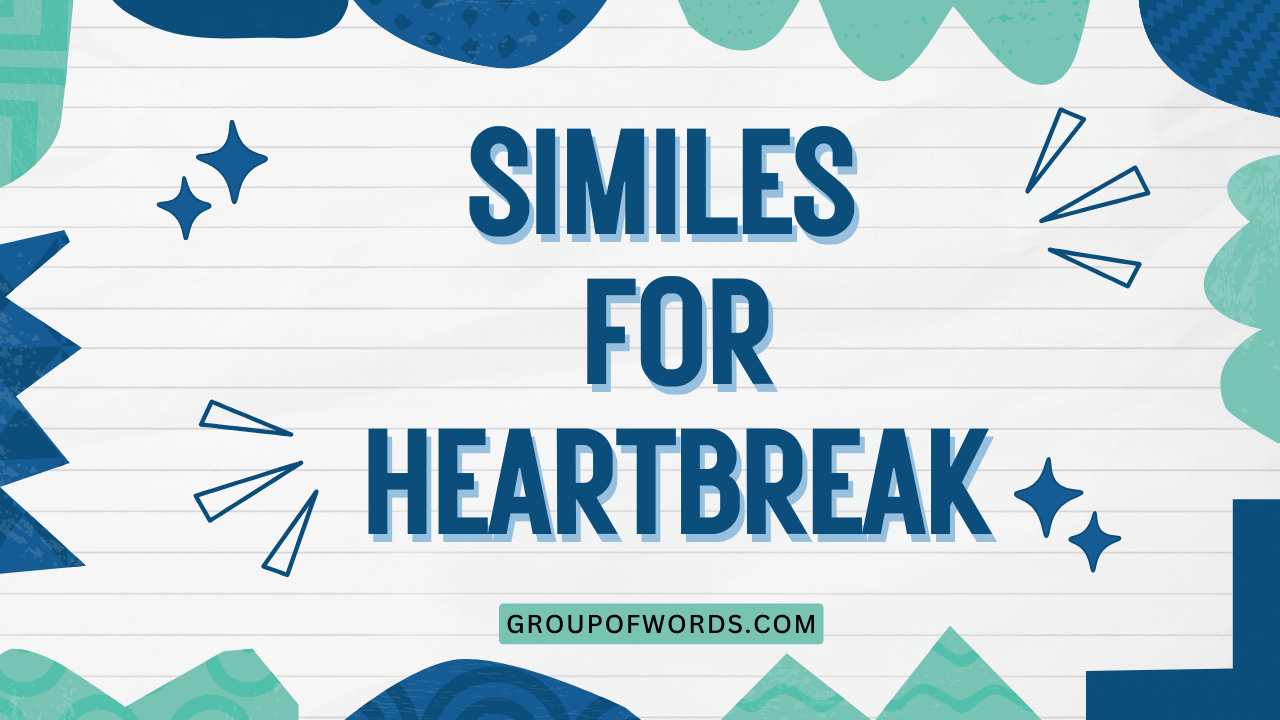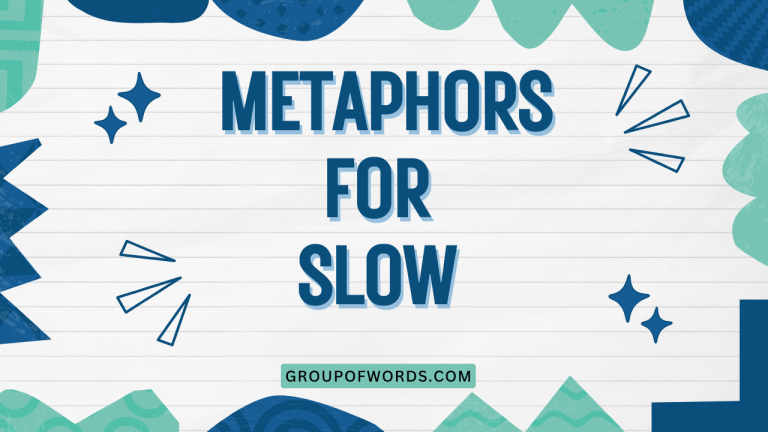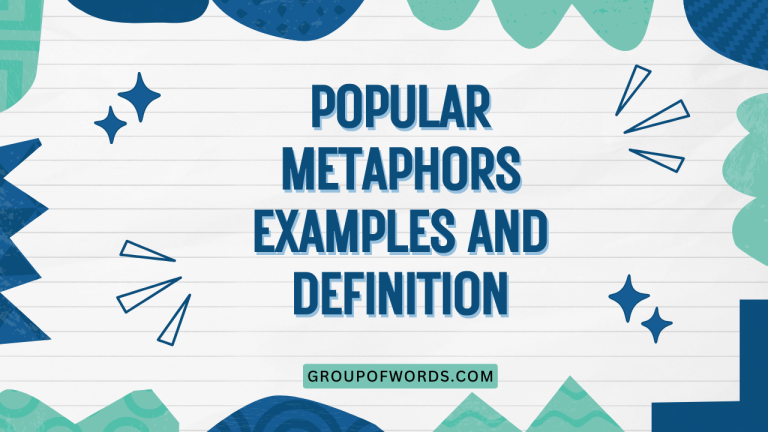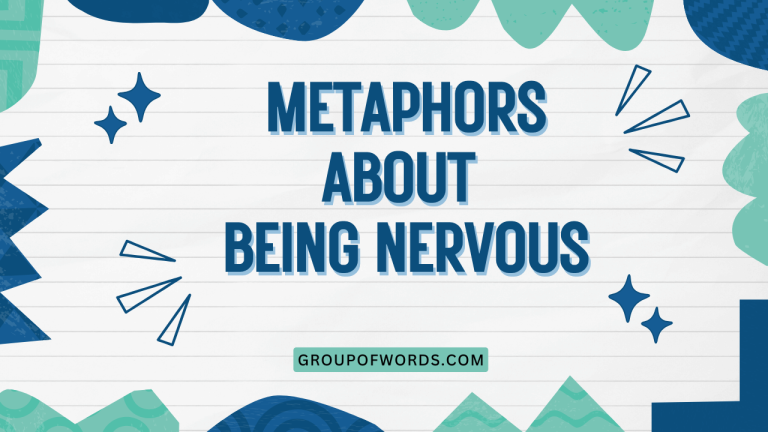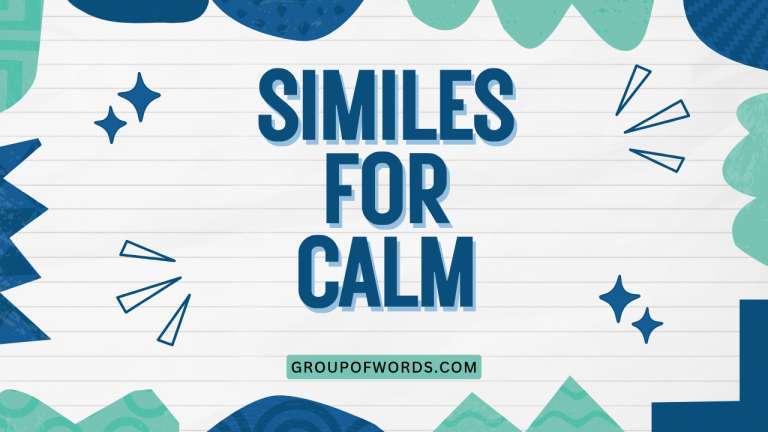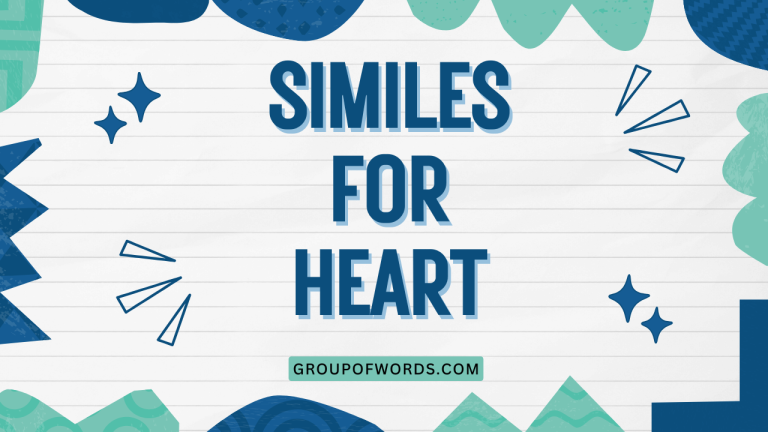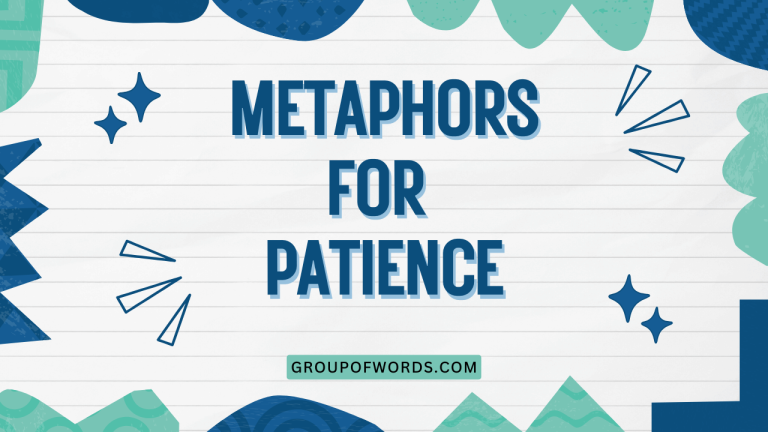Heartbreak Similes: Expressing Pain Through Figurative Language
Heartbreak is a universal human experience, often described with a wide range of emotions, from deep sadness to overwhelming anger. Similes, a powerful tool in the English language, allow us to articulate the abstract and complex feelings associated with heartbreak by comparing them to more concrete and relatable experiences.
Understanding how to use similes effectively can enhance both our expressive abilities and our comprehension of literature and everyday conversations. This article will explore the nuances of heartbreak similes, providing definitions, structural breakdowns, examples, usage rules, common mistakes, practice exercises, and advanced topics to help you master this essential aspect of figurative language.
Whether you are a student, writer, or simply someone interested in improving your English skills, this guide will offer valuable insights and practical knowledge.
Table of Contents
- Introduction
- Definition of Simile
- Structural Breakdown of Heartbreak Similes
- Types of Heartbreak Similes
- Examples of Heartbreak Similes
- Usage Rules for Heartbreak Similes
- Common Mistakes with Heartbreak Similes
- Practice Exercises
- Advanced Topics in Heartbreak Similes
- Frequently Asked Questions
- Conclusion
Definition of Simile
A simile is a figure of speech that directly compares two different things using the words “like” or “as.” The purpose of a simile is to create a vivid image or to emphasize a particular quality of one thing by associating it with another. Similes are widely used in literature, poetry, and everyday conversation to make descriptions more engaging and relatable.
They help us understand abstract concepts by linking them to more familiar experiences. The effectiveness of a simile depends on the clarity and originality of the comparison.
In the context of heartbreak, similes are particularly useful for expressing the intense emotions that are often difficult to articulate directly. By comparing feelings of sadness, loss, or pain to tangible objects or experiences, we can convey the depth and complexity of heartbreak in a more impactful way.
Structural Breakdown of Heartbreak Similes
The basic structure of a simile consists of three main elements:
- The subject: The thing being described (in this case, heartbreak or a specific emotion associated with it).
- The comparison word: “Like” or “as.”
- The object of comparison: The thing to which the subject is being compared.
The formula can be represented as: Subject + Comparison Word + Object of Comparison. For example, “My heart feels like a shattered vase” illustrates this structure. “My heart” is the subject, “like” is the comparison word, and “a shattered vase” is the object of comparison. The effectiveness of the simile hinges on the connection between the subject and the object; the more relatable and evocative the object, the stronger the simile.
Similes can also incorporate additional descriptive words to enhance the image. For example, “My heart feels like a fragile, shattered vase” adds the adjective “fragile” to provide more detail about the state of the vase and, by extension, the heart.
Types of Heartbreak Similes
Heartbreak encompasses a range of emotions, and similes can be tailored to reflect these different facets. Here are some common types of heartbreak similes:
Similes of Sadness and Grief
These similes focus on expressing the feelings of sorrow, despair, and mourning that accompany heartbreak. They often use imagery related to water, darkness, or heaviness to convey the weight of sadness.
Similes of Emptiness and Loss
These similes capture the sense of hollowness and absence that results from the loss of a loved one. They frequently employ imagery of voids, barren landscapes, or silent spaces.
Similes of Pain and Suffering
These similes emphasize the physical and emotional pain caused by heartbreak. They often use imagery of wounds, sharp objects, or burning sensations to illustrate the intensity of the pain.
Similes of Betrayal and Deception
These similes express the feelings of being deceived, double-crossed, or let down by someone trusted. They often use imagery of backstabbing, venom, or broken promises.
Similes of Anger and Resentment
These similes convey the feelings of frustration, rage, and bitterness that can arise from heartbreak. They frequently employ imagery of fire, storms, or explosions to depict the intensity of the anger.
Examples of Heartbreak Similes
Below are several examples of heartbreak similes, organized by the type of emotion they express. Each table provides a variety of similes to illustrate the different ways these feelings can be conveyed.
Examples of Sadness Similes
The following table illustrates similes that convey feelings of sadness and grief associated with heartbreak. They use comparisons that evoke a sense of sorrow, despair, and mourning.
| Simile | Explanation |
|---|---|
| My heart is as heavy as a stone. | The weight of sadness is compared to the physical heaviness of a stone. |
| Tears streamed down my face like a waterfall. | The continuous flow of tears is likened to a cascading waterfall. |
| I felt as lost as a ship without a sail. | The feeling of being directionless and without guidance is compared to a ship lost at sea. |
| My soul felt like a wilted flower. | The loss of vitality and beauty is compared to a flower that has withered. |
| The world seemed as gray as a cloudy day. | The lack of color and joy in the world is compared to a dull, overcast day. |
| Her voice was as shaky as a leaf in the wind. | The instability and fragility of her voice are compared to a leaf trembling in the wind. |
| His heart was as cold as ice. | The lack of warmth and affection is compared to the frigidity of ice. |
| I felt like I was drowning in sorrow. | The overwhelming feeling of sadness is compared to the sensation of drowning. |
| My dreams shattered like glass. | The sudden and irreversible destruction of dreams is compared to breaking glass. |
| Life felt as bleak as a winter landscape. | The desolation and barrenness of life are compared to a desolate winter scene. |
| My spirit was as crushed as a dried leaf underfoot. | The feeling of being utterly defeated and broken is compared to a leaf crushed underfoot. |
| The memories haunted me like ghosts. | The persistent and unsettling presence of memories is compared to haunting ghosts. |
| I felt as empty as a well that has run dry. | The feeling of being completely devoid of emotion is compared to a dry well. |
| Her laughter sounded as hollow as an echo. | The insincerity and lack of joy in her laughter are compared to a hollow echo. |
| My heart ached like a persistent, dull throb. | The constant, underlying pain is compared to a dull throbbing ache. |
| The tears flowed as freely as a river after a storm. | The unrestrained outpouring of tears is likened to a river overflowing after a storm. |
| I felt as fragile as a butterfly’s wing. | The vulnerability and delicacy of one’s emotional state are compared to a butterfly’s wing. |
| The silence was as thick as fog. | The heavy, oppressive nature of the silence is compared to dense fog. |
| My hopes sank like stones in the sea. | The complete and irreversible failure of hopes is compared to stones sinking in the sea. |
| I was as numb as if frozen in ice. | The complete emotional detachment is compared to being frozen. |
Examples of Emptiness Similes
This table provides similes that express the feeling of emptiness and loss that often accompanies heartbreak. They use comparisons that evoke a sense of hollowness, absence, and desolation.
| Simile | Explanation |
|---|---|
| My heart felt as empty as a deserted house. | The feeling of being devoid of love and connection is compared to an empty house. |
| Life was like a barren desert. | The lack of fulfillment and joy in life is compared to a desolate desert. |
| I felt as hollow as a drum. | The feeling of being empty inside is compared to the hollowness of a drum. |
| My soul was like a vacant room. | The absence of warmth and emotion in the soul is compared to an empty room. |
| The world felt as silent as a tomb. | The lack of life and activity in the world is compared to the silence of a tomb. |
| I felt like a ghost, wandering aimlessly. | The feeling of being disconnected and without purpose is compared to a wandering ghost. |
| My future seemed as blank as a white canvas. | The lack of direction and purpose in the future is compared to a blank canvas. |
| I felt as lost as a star in the daylight. | The feeling of being insignificant and unseen is compared to a star invisible in daylight. |
| My laughter sounded as empty as a broken promise. | The insincerity and lack of joy in laughter are compared to a broken promise. |
| The days stretched out like an endless void. | The feeling of time passing without purpose is compared to an endless void. |
| I felt as if a part of me was missing, like a limb had been amputated. | The feeling of incompleteness and loss is compared to the physical loss of a limb. |
| My life felt as meaningless as a forgotten dream. | The lack of purpose and significance in life is compared to a forgotten dream. |
| I was as alone as the last tree standing in a clear-cut forest. | The feeling of utter isolation is compared to a lone tree in a devastated forest. |
| My joy had vanished like smoke in the wind. | The sudden and complete disappearance of joy is compared to smoke dissipating in the wind. |
| My heart felt as vacant as an abandoned theater. | The absence of emotion and activity is compared to an abandoned theater. |
| I was adrift like a boat without oars. | The feeling of being lost and without control is compared to a boat without oars. |
| My world felt as desolate as a lunar landscape. | The barren and lifeless feeling is compared to the surface of the moon. |
| I felt as insubstantial as a shadow. | The feeling of lacking substance or importance is compared to a shadow. |
| My future looked as bleak as a starless night. | The lack of hope and promise is compared to a night without stars. |
| I was as disconnected as a phone with a broken line. | The feeling of being unable to communicate or connect with others is compared to a broken phone line. |
Examples of Pain Similes
The following table presents similes that express the pain and suffering associated with heartbreak. They use comparisons that evoke a sense of physical and emotional anguish.
| Simile | Explanation |
|---|---|
| My heart felt like it was being stabbed with a knife. | The intense emotional pain is compared to the sharp pain of a knife wound. |
| The pain was as sharp as broken glass. | The piercing and acute pain is compared to the sharpness of broken glass. |
| It felt like a burning fire in my chest. | The intense emotional pain is compared to the burning sensation of a fire. |
| The memories were like thorns in my side. | The persistent and irritating nature of the memories is compared to thorns. |
| My heart ached like a broken bone. | The deep and persistent pain is compared to the pain of a broken bone. |
| The rejection stung like a bee sting. | The sharp and immediate pain of rejection is compared to a bee sting. |
| The heartache was as heavy as a physical burden. | The weight of emotional pain is compared to a heavy physical load. |
| My soul felt like it was being torn apart. | The intense emotional pain is compared to the sensation of being torn apart. |
| The pain was as raw as an open wound. | The intense and exposed nature of the pain is compared to an open wound. |
| It felt like a constant, dull ache. | The persistent and underlying pain is described. |
| The betrayal cut me like a razor. | The sharp and precise pain of betrayal is compared to a razor cut. |
| My tears felt like acid, burning my cheeks. | The corrosive and painful nature of tears is compared to acid. |
| The grief was as suffocating as a tightrope around my throat. | The overwhelming and restrictive nature of grief is compared to a tightrope. |
| The pain was as unrelenting as a pounding headache. | The continuous and persistent pain is compared to a headache. |
| My heart shattered like a dropped mirror. | The sudden and irreparable damage is compared to a shattered mirror. |
| The loss hit me like a tidal wave. | The overwhelming and sudden impact of the loss is compared to a tidal wave. |
| The pain was as piercing as an icicle through the heart. | The sharp, cold pain is compared to an icicle piercing the heart. |
| My world crumbled like a sandcastle. | The complete and sudden destruction of one’s world is compared to a collapsing sandcastle. |
| The memories haunted me like relentless ghosts. | The persistent and disturbing presence of memories is compared to haunting ghosts. |
| My spirit was as bruised as a peach. | The sensitivity and damage to one’s spirit are compared to a bruised peach. |
Examples of Betrayal Similes
This table includes similes that express feelings of betrayal and deception. They use comparisons that evoke a sense of being deceived or let down.
| Simile | Explanation |
|---|---|
| His words were as sharp as daggers. | The hurtful impact of his words is compared to sharp daggers. |
| I felt like I had been stabbed in the back. | The feeling of being betrayed by someone trusted is compared to a backstabbing. |
| Her promises were as hollow as a drum. | The insincerity and emptiness of her promises are compared to a hollow drum. |
| The truth was like a bitter pill to swallow. | The unpleasant and difficult nature of the truth is compared to a bitter pill. |
| His lies were as tangled as a spiderweb. | The complexity and deceitfulness of his lies are compared to a spiderweb. |
| I felt like a puppet on a string. | The feeling of being manipulated and controlled is compared to a puppet. |
| The trust was broken like a fragile vase. | The irreversible damage to trust is compared to a broken vase. |
| The betrayal stung like venom. | The painful and poisonous nature of betrayal is compared to venom. |
| His smile was as fake as a plastic flower. | The insincerity and artificiality of his smile are compared to a plastic flower. |
| I felt as if the ground had been pulled out from under me. | The feeling of instability and shock is described. |
| His actions were as deceptive as a mirage. | The misleading and illusory nature of his actions is compared to a mirage. |
| Her loyalty was as fleeting as a summer breeze. | The impermanence and unreliability of her loyalty are compared to a summer breeze. |
| The secret was like a ticking time bomb. | The potential danger and impending revelation of the secret are compared to a time bomb. |
| His deception was as cunning as a fox. | The clever and strategic nature of his deception is compared to a fox. |
| His betrayal felt like a punch to the gut. | The sudden and painful impact of the betrayal is compared to a punch. |
| Their friendship was as fragile as thin ice. | The ease with which the friendship could break is compared to thin ice. |
| Her words were as sweet as honey, but full of lies. | The deceptive sweetness is compared to honey masking lies. |
| The truth unraveled like a cheap sweater. | The quick and easy disintegration of the truth is compared to a cheap sweater. |
| I felt as naive as a lamb led to slaughter. | The feeling of being unknowingly led into a dangerous situation is compared to a lamb. |
| His promises were as empty as the wind. | The lack of substance and reliability of his promises are compared to the wind. |
Examples of Anger Similes
The following table includes similes that express feelings of anger and resentment related to heartbreak. They use comparisons that evoke a sense of frustration, rage, and bitterness.
| Simile | Explanation |
|---|---|
| My anger burned like a wildfire. | The intense and uncontrolled nature of the anger is compared to a wildfire. |
| I felt as furious as a raging storm. | The overwhelming and destructive anger is compared to a storm. |
| My rage was like a volcano about to erupt. | The suppressed and impending release of anger is compared to a volcano. |
| I was as bitter as gall. | The intense resentment and bitterness are compared to gall. |
| My frustration was boiling like a pot on the stove. | The building and intensifying frustration is compared to a boiling pot. |
| I felt like I could explode with anger. | The intense and overwhelming feeling of anger is described. |
| My words were as sharp as knives. | The hurtful and cutting nature of the words is compared to knives. |
| The resentment simmered like a slow-burning fire. | The persistent and underlying resentment is compared to a slow fire. |
| I was as mad as a hornet. | The extreme irritability and aggression are compared to a hornet. |
| My temper flared like a match. | The sudden and intense outburst of anger is compared to a match. |
| The anger coursed through me like electricity. | The intense and energizing nature of the anger is compared to electricity. |
| I was as enraged as a bull seeing red. | The uncontrollable and violent anger is compared to a bull. |
| My fury was as destructive as a tornado. | The devastating and chaotic nature of the fury is compared to a tornado. |
| The bitterness clung to me like a stubborn stain. | The persistent and difficult-to-remove nature of the bitterness is compared to a stain. |
| My anger was as hot as molten lava. | The intense and destructive nature of the anger is compared to lava. |
| I felt as volatile as nitroglycerin. | The easily triggered and explosive nature of one’s emotions is compared to nitroglycerin. |
| My resentment grew like a weed. | The uncontrolled and unwanted growth of resentment is compared to a weed. |
| I was as furious as a cornered animal. | The desperation and ferocity of one’s anger are compared to a cornered animal. |
| My rage surged like a tsunami. | The overwhelming and destructive force of the rage is compared to a tsunami. |
| I was as indignant as a wrongly accused person. | The feeling of righteous anger is compared to someone wrongly accused. |
Usage Rules for Heartbreak Similes
When using similes to describe heartbreak, it’s important to adhere to certain rules to ensure clarity and effectiveness:
- Use “like” or “as”: These are the essential comparison words that define a simile.
- Compare dissimilar things: The subject and object of comparison should be different enough to create a meaningful connection. Comparing “sadness like sadness” is redundant and ineffective.
- Ensure the comparison is clear: The connection between the subject and object should be easily understood. Avoid obscure or overly complex comparisons.
- Be original: While common similes can be effective, try to create fresh and unique comparisons to make your writing more engaging.
- Consider the context: The simile should be appropriate for the tone and style of the writing. Avoid using humorous similes when describing serious heartbreak.
Common Mistakes with Heartbreak Similes
Here are some common mistakes to avoid when using similes for heartbreak:
| Incorrect | Correct | Explanation |
|---|---|---|
| My heart is like red. | My heart is like a bleeding wound. | The comparison is too vague. The correct version provides a clearer and more evocative image. |
| He was sad as sad. | He was as sad as a lonely child. | The comparison is redundant. The correct version provides a more specific and meaningful comparison. |
| The pain felt similar to pain. | The pain felt like shards of glass in my heart. | The comparison is too generic. The correct version uses a vivid image to convey the intensity of the pain. |
| She was angry as a person. | She was as angry as a disturbed wasp nest. | The comparison is too general. The improved simile is more specific. |
| My heart felt empty like air. | My heart felt as empty as a deflated balloon. | The comparison is too vague. The revised sentence is more descriptive. |
Practice Exercises
Test your understanding of heartbreak similes with these exercises. For each sentence, create a simile that effectively conveys the emotion described.
Exercise 1: Identify the emotion and complete the simile.
| Question | Answer |
|---|---|
| 1. After the breakup, she felt ________ like ________. (Emotion: Sadness) | She felt sorrowful like a weeping willow. |
| 2. His betrayal made him feel ________ as ________. (Emotion: Betrayal) | His betrayal made him feel deceived as Judas betrayed Jesus. |
| 3. The pain of losing her was ________ like ________. (Emotion: Pain) | The pain of losing her was excruciating like a burn victim’s skin. |
| 4. The emptiness he felt was ________ as ________. (Emotion: Emptiness) | The emptiness he felt was vast as the desert at night. |
| 5. Her anger was ________ like ________. (Emotion: Anger) | Her anger was intense like a volcano’s eruption. |
| 6. After the argument, he felt ________ like ________. (Emotion: Regret) | After the argument, he felt remorseful like a child caught stealing. |
| 7. The fear of being alone was ________ as ________. (Emotion: Fear) | The fear of being alone was terrifying as walking through a graveyard at midnight. |
| 8. Her jealousy was ________ like ________. (Emotion: Jealousy) | Her jealousy was consuming like a wildfire spreading through a forest. |
| 9. The hope he lost felt ________ as ________. (Emotion: Hopelessness) | The hope he lost felt gone as a star during the day. |
| 10. The feeling of being unwanted was ________ like ________. (Emotion: Unwanted) | The feeling of being unwanted was crushing like an insect underfoot. |
Exercise 2: Rewrite the sentences using similes.
| Question | Answer |
|---|---|
| 1. She was very sad after the breakup. | She was as sad as a lonely cloud weeping rain after the breakup. |
| 2. He felt completely empty inside. | He felt as empty inside as a hollow tree trunk. |
| 3. The pain was very intense. | The pain was as intense as a searing brand on his skin. |
| 4. Her betrayal was very hurtful. | Her betrayal was as hurtful as a dagger thrust into his heart. |
| 5. He was extremely angry. | He was as extremely angry as a cornered lion. |
| 6. She felt incredibly alone. | She felt as incredibly alone as the last person on Earth. |
| 7. The regret was overwhelming. | The regret was as overwhelming as a flood washing over a town. |
| 8. The fear was paralyzing. | The fear was as paralyzing as being trapped in ice. |
| 9. The disappointment was profound. | The disappointment was as profound as falling into a bottomless pit. |
| 10. The loss was unbearable. | The loss was as unbearable as carrying the weight of the world on his shoulders. |
Advanced Topics in Heartbreak Similes
For advanced learners, consider these more complex aspects of similes:
- Extended Similes: Developing a simile over multiple sentences or paragraphs to create a more elaborate and immersive image.
- Juxtaposition: Using similes to compare contrasting emotions or experiences within the context of heartbreak.
- Subverting Expectations: Creating similes that challenge conventional comparisons to achieve a unique or ironic effect.
- Blending Similes and Metaphors: Creating hybrid figures of speech.
Frequently Asked Questions
- What is the difference between a simile and a metaphor?
A simile directly compares two things using “like” or “as,” while a metaphor implies a comparison without using these words. For example, “My heart is like a stone” is a simile, whereas “My heart is a stone” is a metaphor.
- Can a simile be too cliché?
Yes, overused similes can lose their impact and make your writing seem unoriginal. Try to create fresh and unique comparisons to avoid clichés. Instead of saying “sad like rain,” consider crafting something more evocative, such as “sad like a song unsung.”
- How can I make my similes more effective?
Use vivid and specific language, choose objects of comparison that are relatable and evocative, and ensure that the connection between the subject and object is clear and meaningful.
- Is it okay to use similes in formal writing?
Yes, similes can be used in formal writing, but they should be used sparingly and with careful consideration of the tone and style of the piece. They are more commonly used in creative writing and less common in scientific or technical writing. Choose similes that enhance clarity and add value to the writing without being distracting.
- How do I avoid mixed metaphors when using similes?
Ensure that the images you’re creating with your similes are consistent. A mixed metaphor combines unrelated images, which can confuse or distract the reader. For example, avoid saying something like, “His anger was a volcano sailing on the ocean,” as volcanoes and sailing do not logically connect.
- What’s the role of similes in poetry?
Similes provide vivid imagery and emotional depth, helping poets convey complex feelings and experiences in a relatable way. They enhance the sensory experience of the poem, making it more engaging and memorable for the reader.
- Can similes be culturally specific?
Yes, some similes may resonate more strongly with individuals from certain cultures due to shared experiences or cultural references. When writing for a diverse audience, it’s essential to consider whether the similes you use will be universally understood or if they require cultural context.
- How can I practice using similes effectively?
Practice writing similes regularly by taking everyday experiences or emotions and trying to describe them using different comparisons. Read widely, paying attention to how established writers use similes, and seek feedback on your own writing from peers or mentors.
Conclusion
Mastering the use of similes for describing heartbreak can significantly enhance your ability to express complex emotions and create vivid imagery in your writing. By understanding the structural elements, types, and usage rules of similes, you can effectively convey the depth and intensity of heartbreak in a way that resonates with your audience.
Remember to avoid common mistakes, practice regularly, and explore advanced topics to further refine your skills.
In summary, similes are powerful tools for expressing the multifaceted nature of heartbreak. By consistently practicing and refining your understanding of this literary device, you’ll be well-equipped to articulate the profound emotions associated with loss, pain, and healing.
Keep exploring, keep writing, and let your words paint vivid pictures of the human experience.
